Warning: pic heavy as usual. 
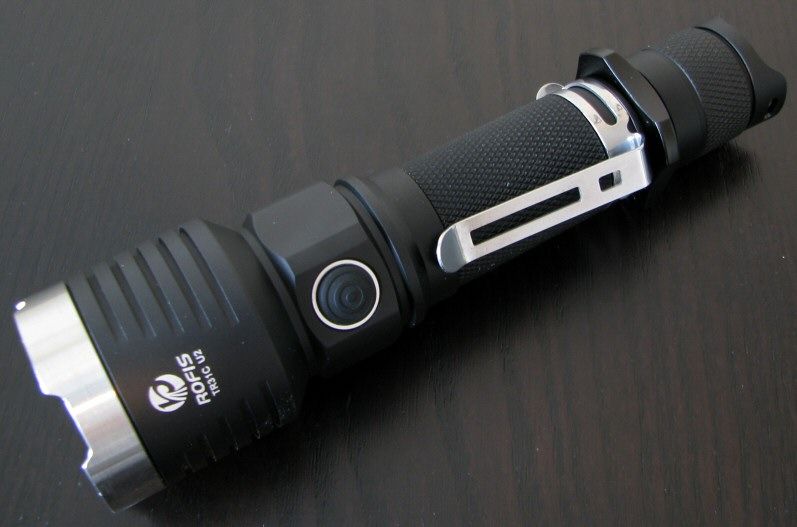
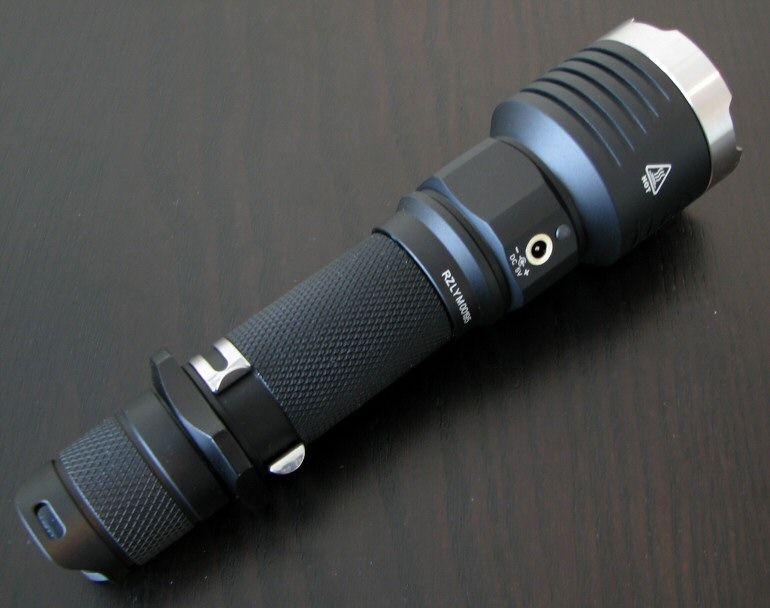
The TR31C is Rofis' first "intelligent rechargeable tactical light". Let's see how it compares to others in its class, including other rechargeable lights.
Manufacturer Reported Specifications:
Note: as always, these are only what the manufacturer reports. To see my actual testing results, scroll down the review.
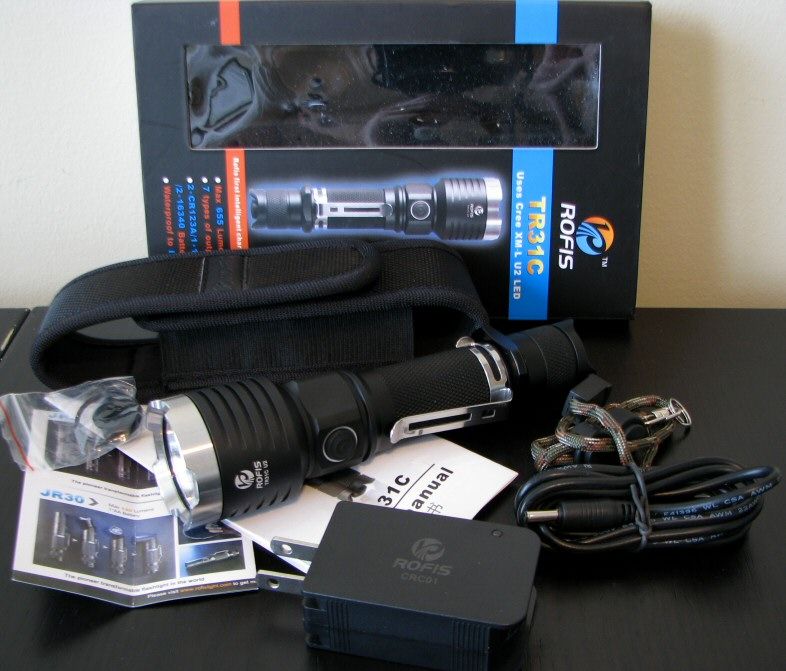
The TR31C comes in a decent kit, with a good number of extras. Inside the hard cardboard box you will find the light (with removable metal grip ring and pocket clip attached) in packaging foam. Also included is a manual, product insert, decent quality holster, charging cable, USB-AC adapter, wrist lanyard, spare boot cover and extra o-rings.
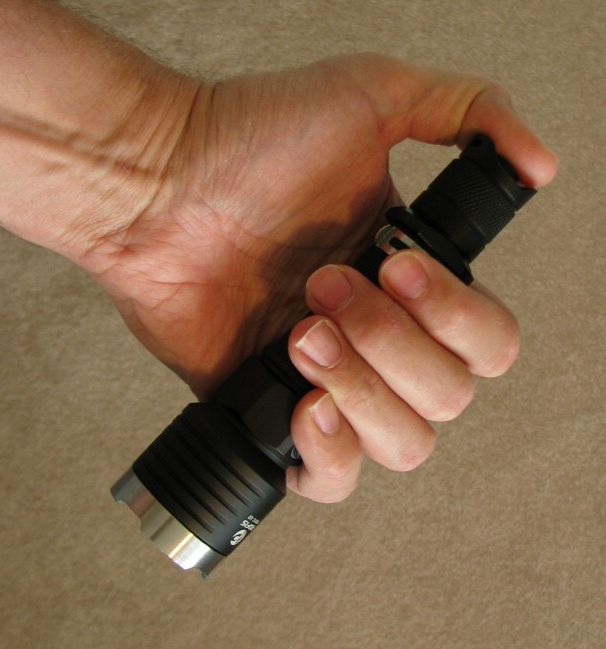
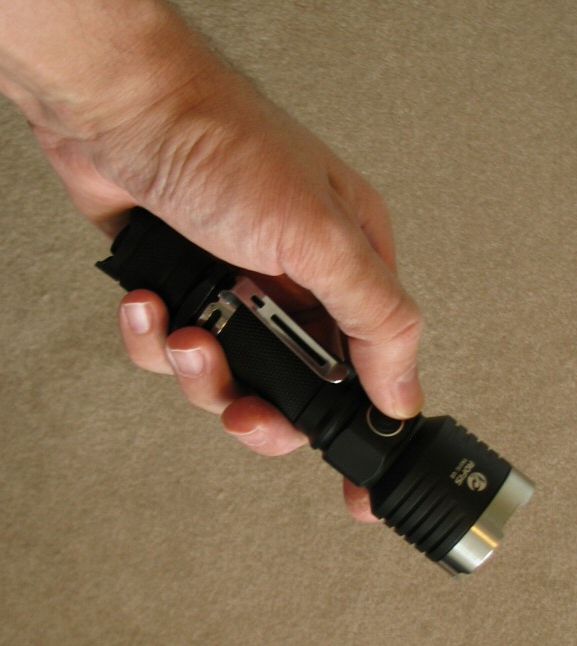
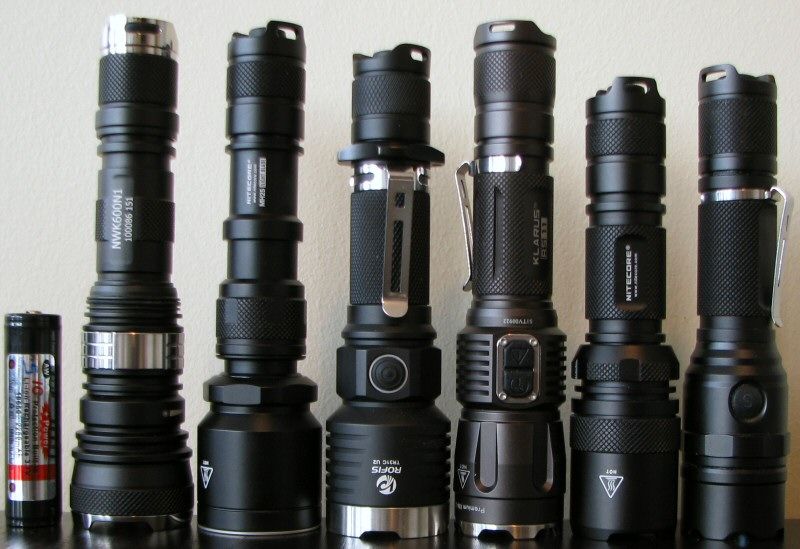
From left to right: AW protected 18650; Niwalker NWK600N1; Nitecore MH25; Rofis TR31C; Klarus RS11; Nitecore MT26; Lumintop PS20.
Rofis TR31C: Weight: 180.7g, Length: 153.0mm, Width (bezel): 39.8mm
Nitecore MH25: Weight: 145.4g, Length: 160mm, Width (bezel): 40.0m
Nitecore MT25: Weight 124.6g, Length: 142.9mm, Width (bezel): 34.2mm
Klarus RS11: Weight 158.0g, Length: 160mm, Width (bezel) 34.9mm
Klarus XT11: Weight 133.0g, Length: 148.8, Width (bezel) 35.0mm
Sunwayman V20C: Weight: 117.4g, Length 133.0mm, Width (bezel) 32.2mm
Thrunite TN10: Weight: 154.7g, Length: 145.5mm, Width (bezel): 35.1mm
Light is a bit heavier than most in this class, and has a good solid feel.
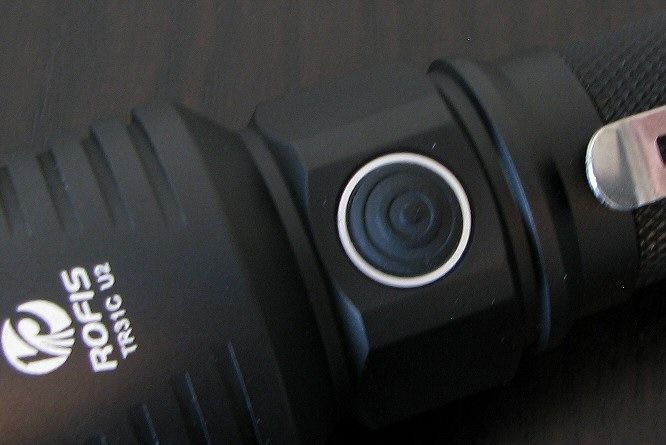
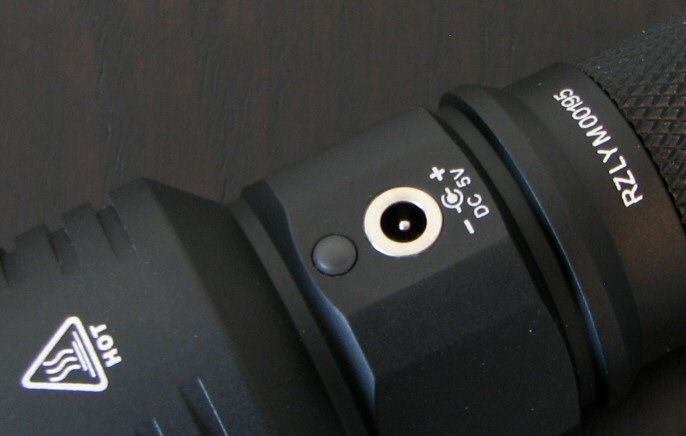
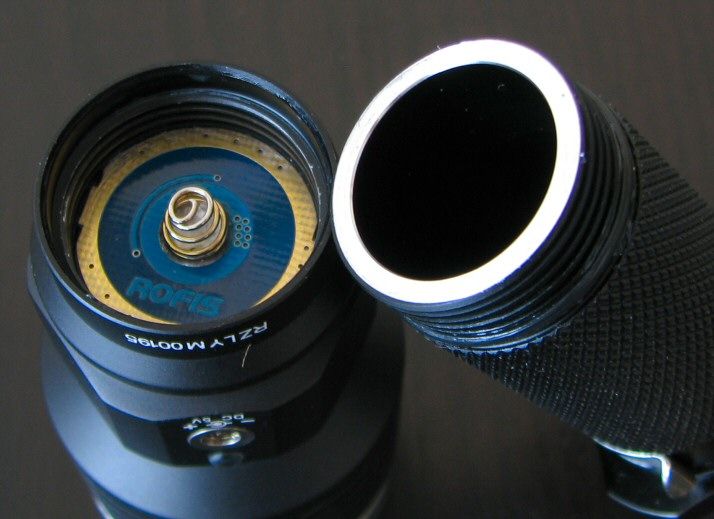
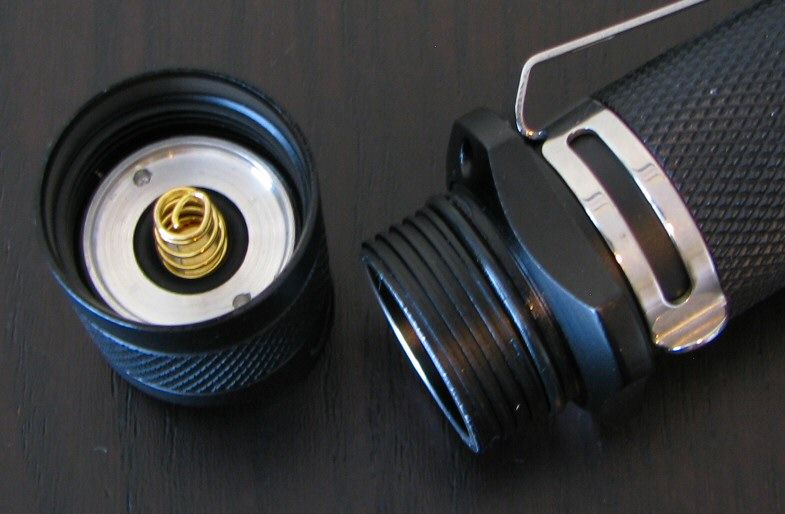
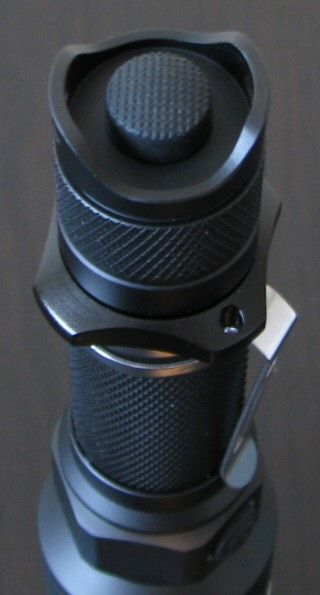
Anodizing is a matte black, with no chips on my samples. Labels are bright white, very sharp and clear against the dark background. A serial number is included. There is a significant amount of knurling across the tailcap and battery tube, of good aggressiveness. Grip is definitely good. Overall weight is substantial for the class.
In addition to the tailcap forward clicky switch, there is a secondary mode-changing electronic switch in the head. Switch feels are about typical for both, certainly on the firm side.
There is a spring on the positive contact point in the head, which flat top cells can be used (confirmed on my sample). The body tube is wide enough to take high-capacity protected 18650 cells. :thumbsup:
Screw threads are standard triangular cut, and seem of good quality. They are also anodized for lock-out at the tailcap and the head.
Light can tailstand, but is a bit wobbly on my sample.
The TR31C comes with stainless steel bezel ring, which is slightly crenaled.
The charging dock uses a standard 12V DC pin-style connector (USB charging cable and USB-AC adapter included). Normally, I would be worried about waterproofness with this sort of design (i.e., there is no rubber plug on my sample). However, one of the Rofis dealers did a waterproof test, and the light performed fine (the video is on YouTube).
There is a LED indicator on the light, which tells you the charging status when the charger is attached.
Incorrectly inserted battery, or tailcap switch not clicked on (i.e., not charging):
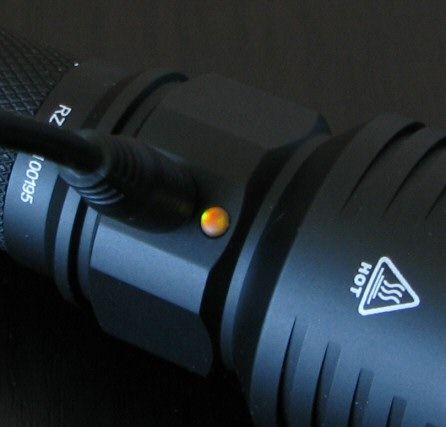
Charging:
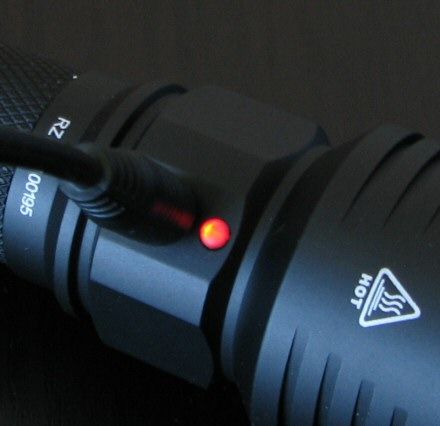
Fully charged:
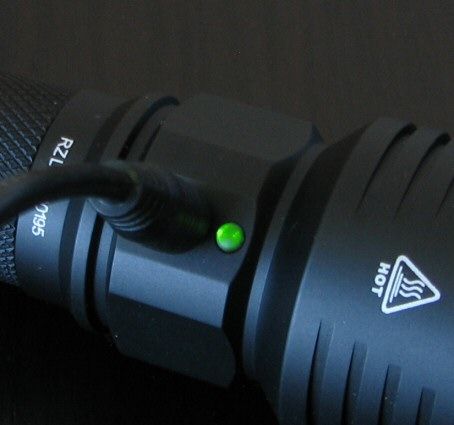
Rofis documentation claims that the charger can charge up to a current of 850mA with the included USB-AC adapter (which has a printed rating of up to 1000mA), but only 500mA when connected to a USB port. Note that standard USB 2.0 specs limit you to 500mA charging current.
From my limited testing, when connected directly to a USB port the charging rate was ~6.5 hours for my 2200mAh 18650 cells. That is consistent with other USB-based 18650 charger lights I've tested. When plugged in to AC power using the supplied adapter, my 2200mAh cells were fully charged within 3 hours. So it looks like Rofis' charging specs are fairly accurate.
Note however that there was one quirk - the charging light wouldn't go green on my TR31C sample at the end of the charge. Instead, it ended with the orange LED indicator (which also tells you the light is not currently charging). Not sure why, but at least charging was terminated once this level was reached. Resting voltage for the cells was a fairly consistent ~4.19-4.20V, which is appropriate.
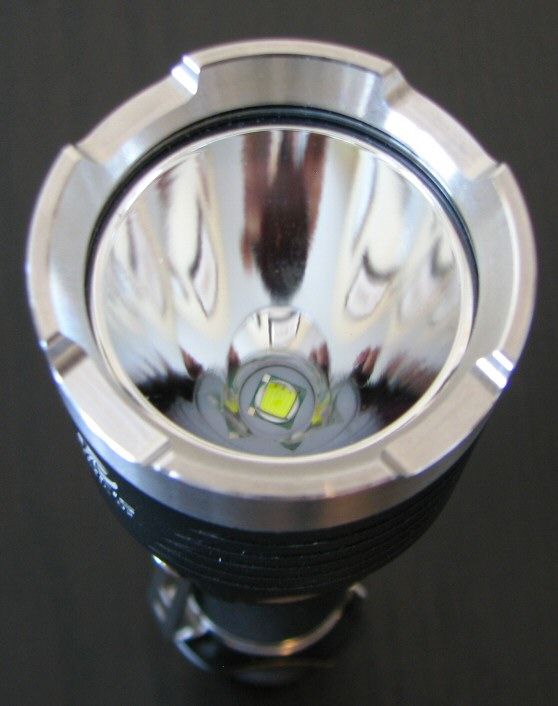
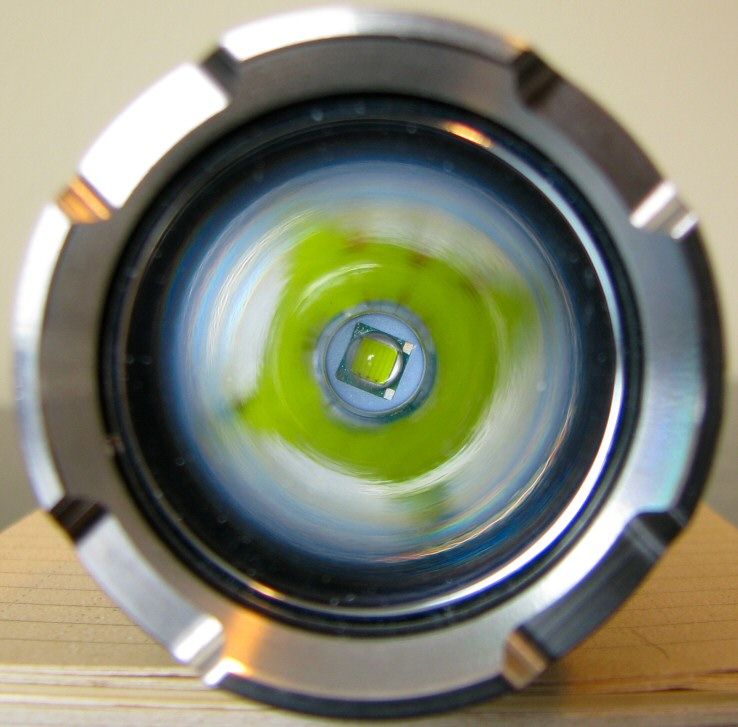
The TR31C has a fairly deep and smooth reflector, which should provide good throw.
User Interface
The TR31 has a forward tailcap clicky - press and release for momentary on, click for locked on.
Mode switching is controlled by the secondary electronic switch in the head. Press and release (i.e., click) to change modes, in the following sequence Lo > Med > Hi > Turbo, in repeating order. The light will memorize the last mode used, and return to it upon re-activation (turn off/on by the tailcap switch).
To access the blinking modes, press and hold the side switch for about 1 sec. You now have Strobe > SOS > Beacon modes, in repeating order (change between them with a single click). Note there is no memory feature for the blinking modes – the light will always come on in the last memorized General constant output mode.
This interface is exactly the same as the Rofis JR30 that I reviewed previously.
For charging a 18650 battery inside the light, you plug the 12 VDC connector into the port at the base of the head of the light. The light will initially come on in max output for ~1sec, and then shut off. The LED charge indicator will turn orange, indicating the light is not currently charging. To start a charge cycle, click the tailcap switch on. The light will not actually come on during charging, but the charge indicator will show green (for fully charged) or red (for currently charging).
Once the battery is fully charged, the indicator is supposed to turn green and terminate the charge. On my sample however, it turned orange (but still seemed to terminate the charge).
As an aside, I am not able to detect an open voltage at the charging port on the TR31C. This is reassuring, as it means you won't accidentally short a cell inside the light during normal use.
Video Overview
For more information on the light, including the build and user interface, please see my new video overview:
As always, videos were recorded in 720p, but YouTube typically defaults to 360p. Once the video is running, you can click on the configuration settings icon and select the higher 480p to 720p options. You can also run full-screen.
PWM/Strobe
I am unable to detect any signs of PWM on any output using my standard soundcard oscilloscope. I believe the light is current-controlled.
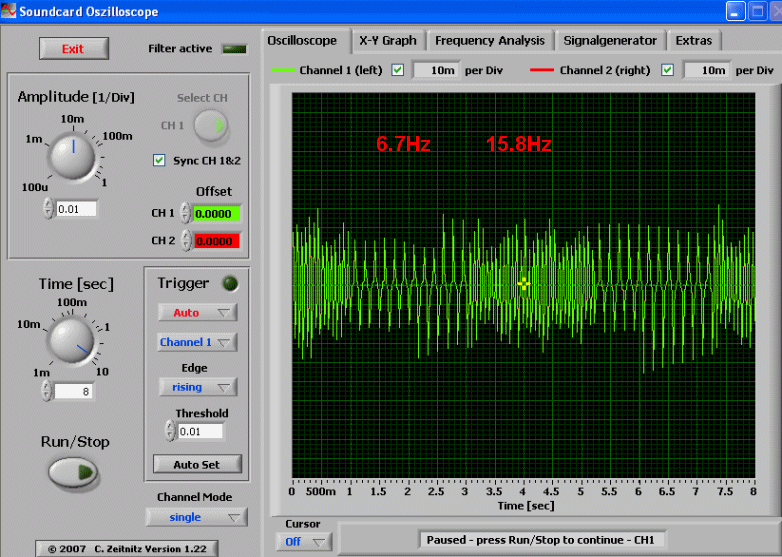
Fast strobe is an alternating strobe, switching between 15.5 Hz and 6.7 Hz every 2 secs. Certainly very disorienting.
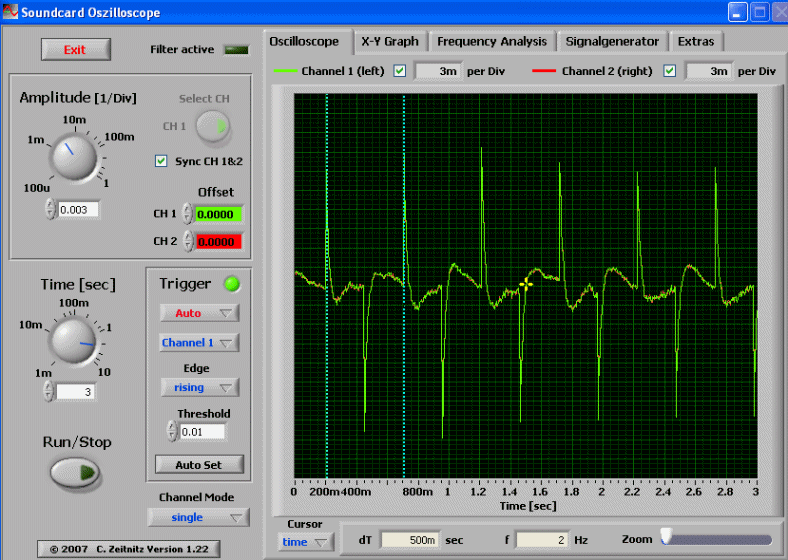
The TR31 also has a slow beacon mode, at 2 Hz. This is much more my speed.
There is also an SOS mode (not shown). These are again similar to my Rofis JR30.
Beamshots:
All lights are on Max output on 1x AW protected 18650 (2200mAh). Lights are about ~0.75 meter from a white wall (with the camera ~1.25 meters back from the wall). Automatic white balance on the camera, to minimize tint differences.
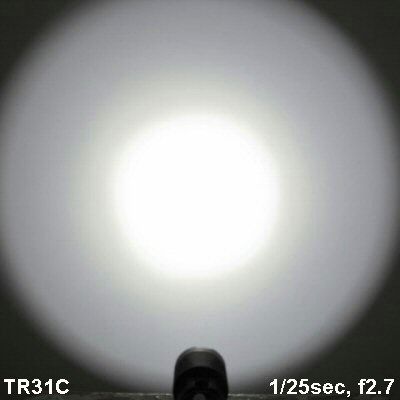
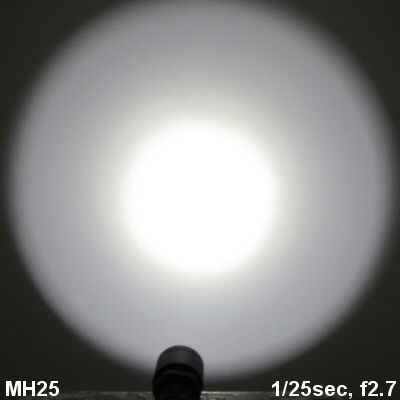
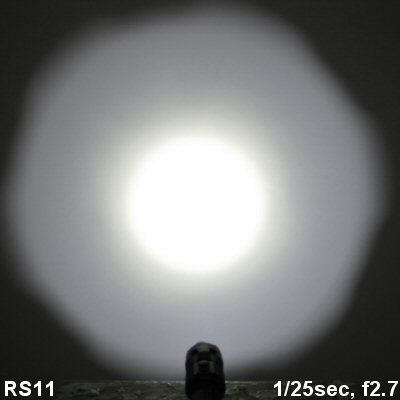
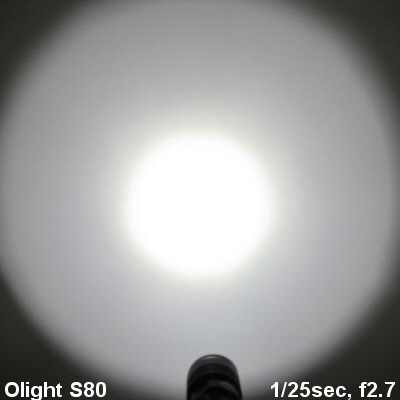
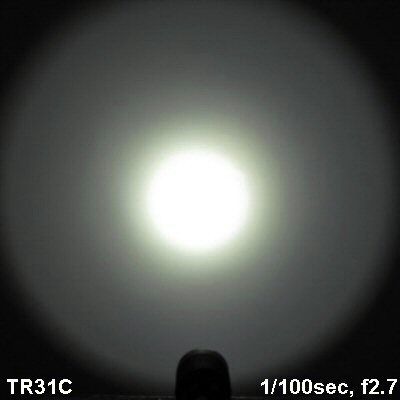
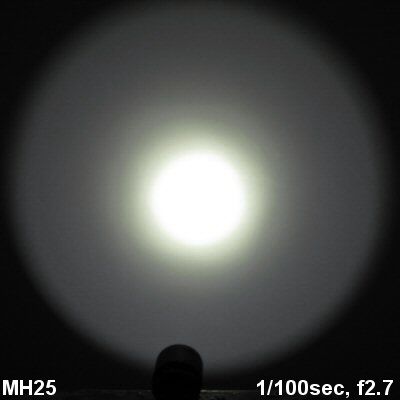
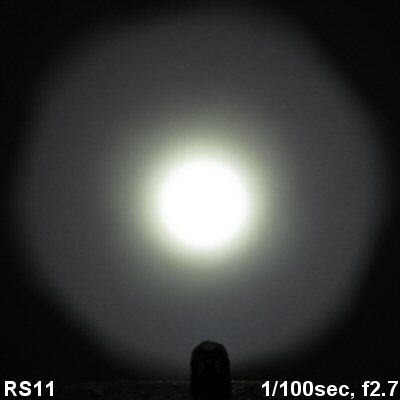
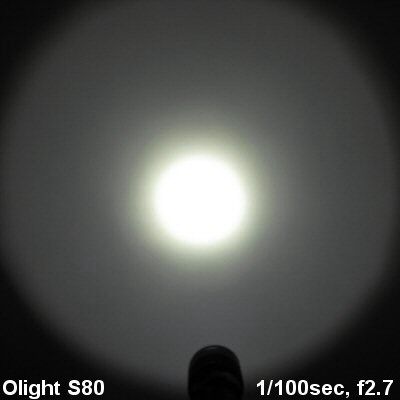
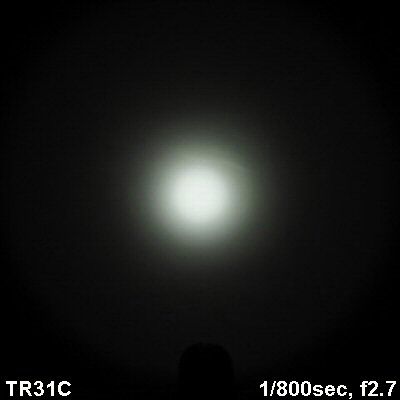
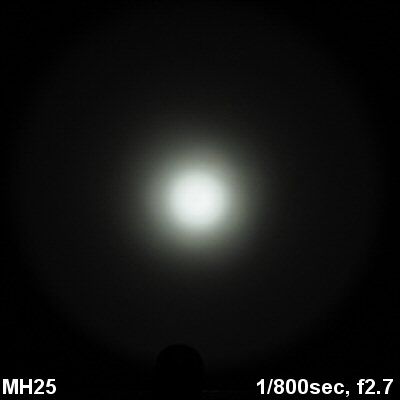
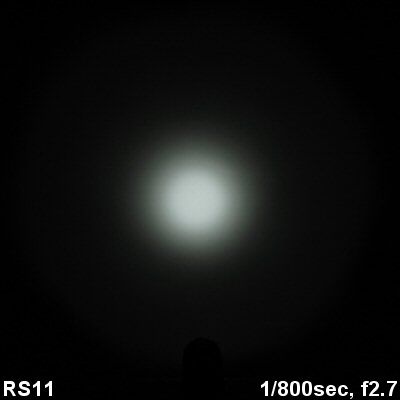
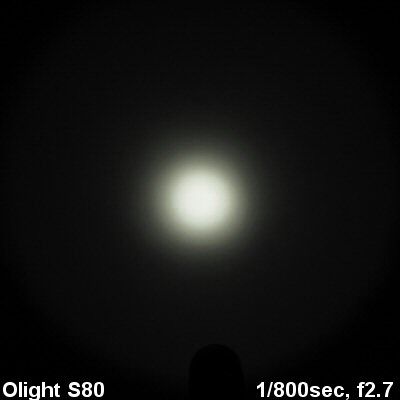
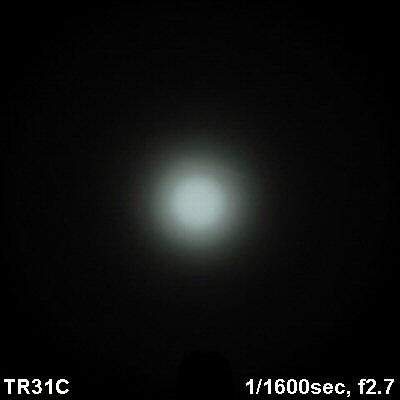
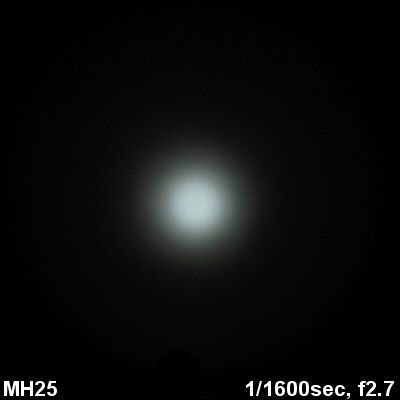
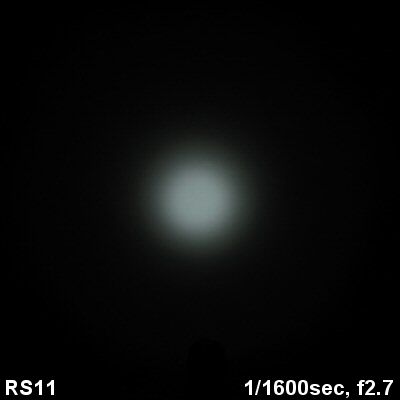
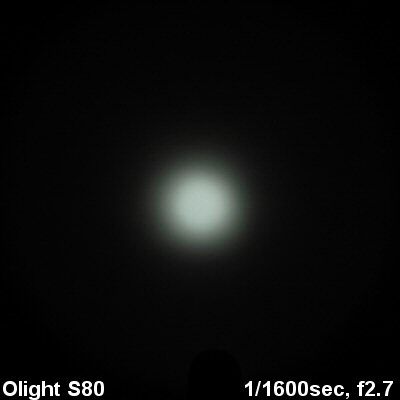
The TR31 has a very reasonable beam for this class and size light. Note by the way that there is no artifact in the corona – that slight horizontal line you might see above is simply a scratch on the wall paint.
Testing Method:
All my output numbers are relative for my home-made light box setup, a la Quickbeam's flashlightreviews.com method. You can directly compare all my relative output values from different reviews - i.e. an output value of "10" in one graph is the same as "10" in another. All runtimes are done under a cooling fan, except for any extended run Lo/Min modes (i.e. >12 hours) which are done without cooling.
I have devised a method for converting my lightbox relative output values (ROV) to estimated Lumens. See my How to convert Selfbuilt's Lightbox values to Lumens thread for more info.
Throw/Output Summary Chart:
My summary tables are reported in a manner consistent with the ANSI FL-1 standard for flashlight testing. Please see http://www.flashlightreviews.ca/FL1.htm for a discussion, and a description of all the terms used in these tables.
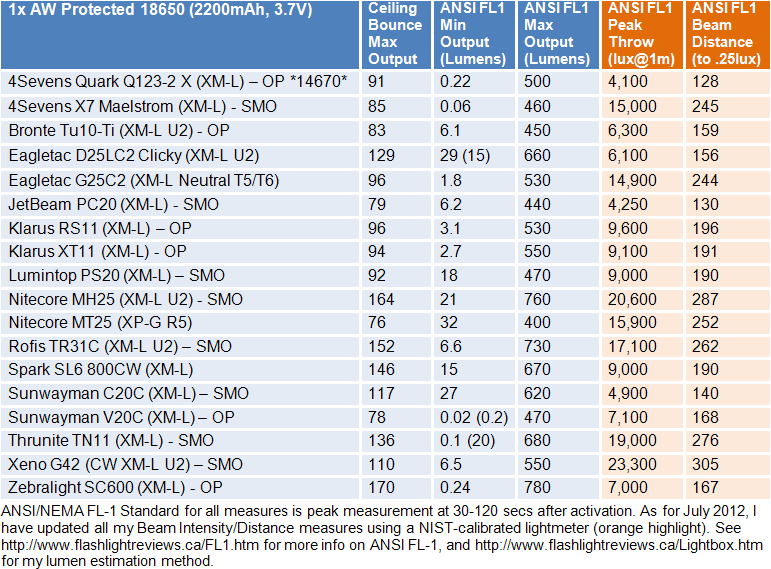
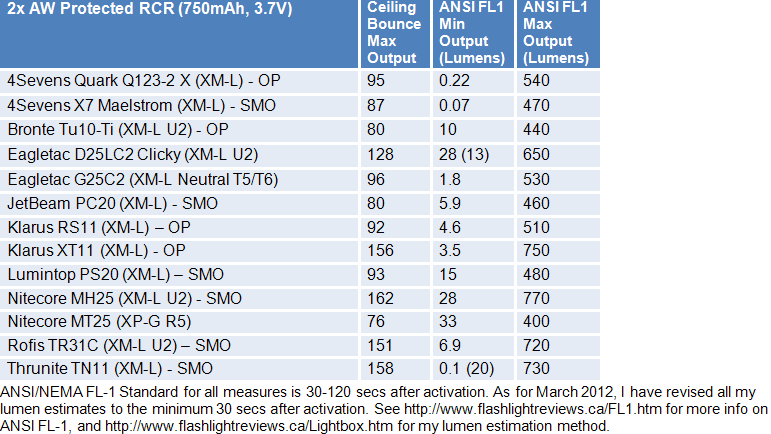
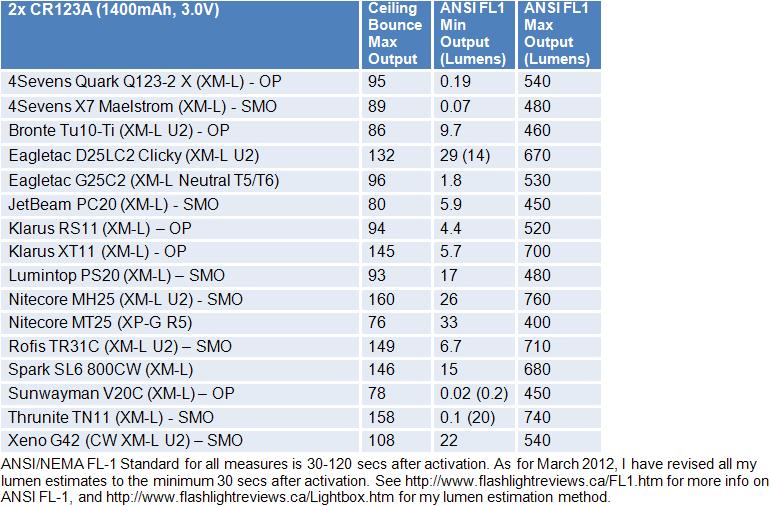
Again, as already observed, throw is reasonably good for the class. My beam intensity and distance measures are bang-on with the published Rofis specs for this light.
Output is also fairly consistent – although the max output seems slightly higher initially in my testing than the published specs indicate.
Output/Runtime Comparison:
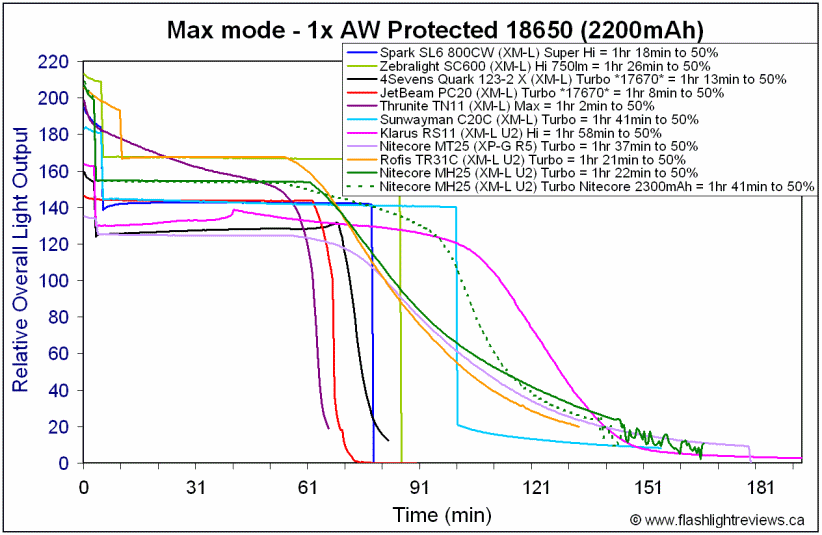
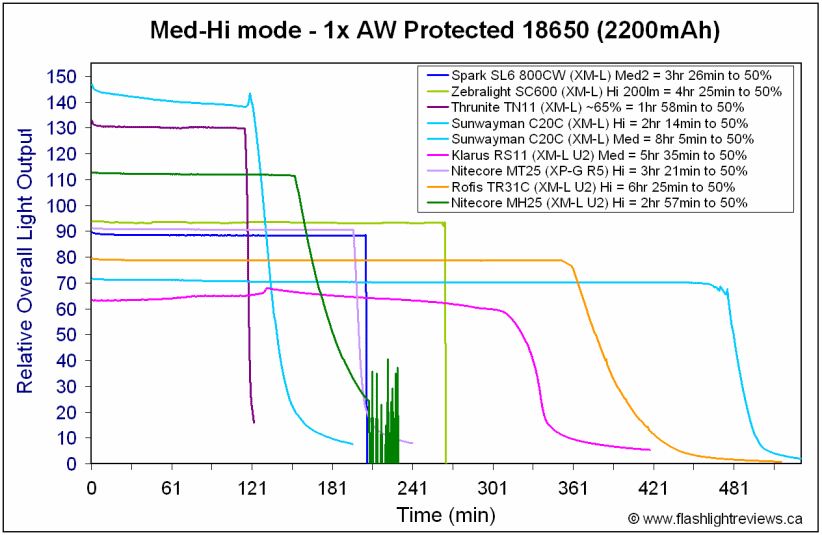
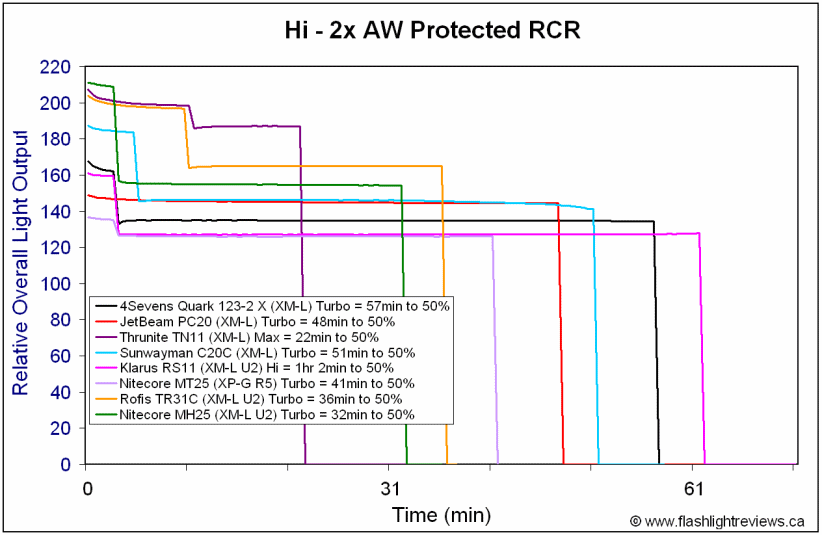
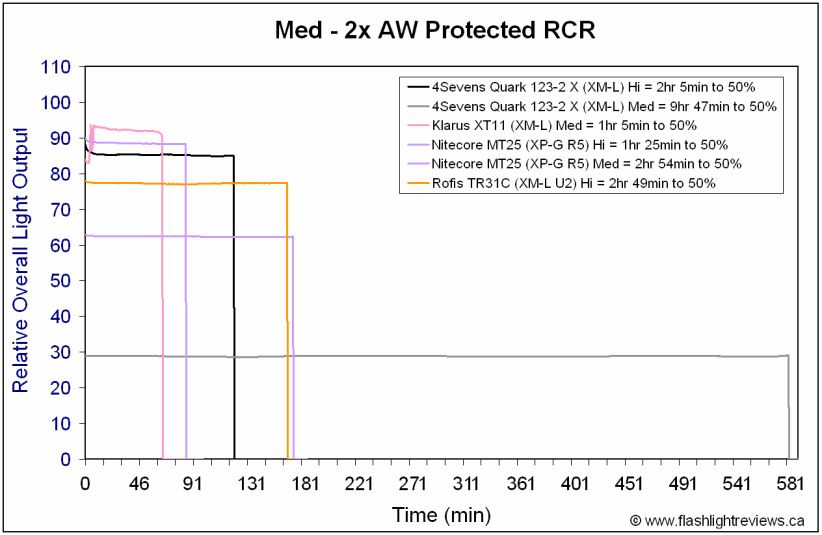
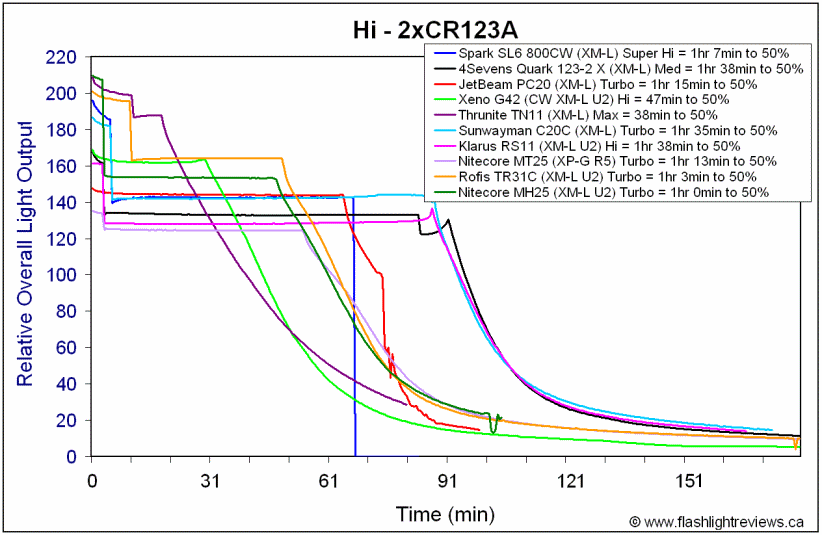
Again, runtime performance seems very consistent with the reported Rofis specs (note that I use the lower capacity 2200mAh 18650 cells in my testing).
On max, on all batteries, the TR31C has a timed step-down in output of ~20% after 10 mins of continuous runtime.
Runtime performance was typically excellent across the levels and batteries I tested, consistent with a good current-controlled circuit. :thumbsup:
Potential Issues
The charging port doesn't have a cover, but a dealer has confirmed water-resistance in an online video (suggesting it is insulated in some way).
You have to remember to click the tail switch on to activate the charger. The charger appears to terminate at a reasonable voltage (~4.19-4.20V in my testing), although it displays the orange indicator at the end of the charge (instead of the reported green).
Preliminary Observations
Rofis continues to impress with its solid designs and excellent current-controlled circuitry. The TR31C also has the added feature of a well-implemented charging solution for 18650.
The TR31C features Rofis' now standard dual-interface design, with a tailcap forward clicky switch for on/off, and a side electronic mode-changing switch. User interface is uncluttered, with blinking modes safely hidden away off the main sequence. I also like Rofis' standard inclusion of a slow signalling strobe/beacon in the flashing mode set.
Styling is always a matter of personal preference, but Rofis continues to try and put a few unique design touches on their models. In this case, the wide stainless steel bezel ring is distinctive. In any case, the light is solidly built, with good weight and overall hand feel. There are good anodized threads for tailcap lock-out, and generous knurling throughout. You should find it easy to handle and use.
As with the other Rofis lights I've tested, the regulation pattern and output/runtime efficiency of the current-controlled circuit was excellent. Reported manufacturer ANSI FL-1 specs were also quite accurate in my testing.
Beam pattern is very good for a light this size, with significant throw and reasonable spill.
I am particularly impressed with the charging solution native to the TR31C. Like many other 1x18650 charging lights, it connects to a computer using the standard USB interface for charging at the USB max of 500mA. But use of the included AC adapter allows you to almost double the charging rate to a reported 850mA. This is a creative solution for a common charging cable (likely made possible by the 12VDC connector dock, instead of using a standard micro-USB). The only quirk is that the indicator light turns orange – not green – when fully charged on my sample, but it seems to terminate at the proper level of ~4.20V. :thumbsup:
Frankly, I see this light hitting all the major points most people look for in a good size, 1x18650, 2xCR123A/RCR light. It is also one of the most versatile in-light 1x18650 charging solutions I've seen. An all-around strong performer, nicely done. :wave:
----
TR31C provided by SBFlashlights.com for review.


The TR31C is Rofis' first "intelligent rechargeable tactical light". Let's see how it compares to others in its class, including other rechargeable lights.
Manufacturer Reported Specifications:
Note: as always, these are only what the manufacturer reports. To see my actual testing results, scroll down the review.
- Cree XM-L LED (U2)
- Battery: 2x CR123A / 1x 18650 / 2x 16340 (16340 battery is not recommended)
- ANSI FL-1 Output/Runtime: Turbo 655 lumens, 1hr40min – High 150 lumens, 7hr 30min – Mid 60 lumens, 20hr – Low 6 lumens, 200 hr – Strobe 655 lumens – SOS 150 lumens – Beacon 150 lumens
- Distance: 260m
- Beam Intensity: 16,900 cd
- Notice: The above-mentioned parameters (tested in lab by using quality CR123A primary Lithium batteries) are approximate and may vary between flashlights, batteries, and environments.
- We suggest you use protected 18650 battery when you charge the light, reverse battery installation is forbidden during charging, the CR123A and 16340 battery are forbidden for charging.
- It can be charged in the car, on the computer and household electric supply device, etc
- Digitally regulated output - maintains constant brightness
- Intelligent memory circuit,automatically memorizes the brightness level when switch off
- Over-discharge protection function, when the battery is in low voltage, the light will flicker twice every two minutes
- Reverse polarity protection, to protect from improper battery installation
- Turbo mode will automatically decline to 500LM after 10 minutes, to protect the light from over-heating.
- Capable of standing up securely on a flat surface to serve as a candle
- stainless steel attack head
- Adopt double-switch design (tail tactical switch, side dimmer switch)
- Made of durable aircraft-grade aluminum
- Impact resistant: 1.5m
- Waterproof: IPX-8, 2m
- Premium Type III hard-anodized anti-abrasive finish
- Toughened ultra-clear glass lens with anti-reflective coating
- 152 mm (length) x 25.4 mm(body ) x 39.8mm(head diameter)
- 180-gram weight (excluding batteries)
- Accessories: USB wire, adapter, holster, umbrella rope, rubber switch boot cover and two spare o-rings
- MSRP: ~$100

The TR31C comes in a decent kit, with a good number of extras. Inside the hard cardboard box you will find the light (with removable metal grip ring and pocket clip attached) in packaging foam. Also included is a manual, product insert, decent quality holster, charging cable, USB-AC adapter, wrist lanyard, spare boot cover and extra o-rings.



From left to right: AW protected 18650; Niwalker NWK600N1; Nitecore MH25; Rofis TR31C; Klarus RS11; Nitecore MT26; Lumintop PS20.
Rofis TR31C: Weight: 180.7g, Length: 153.0mm, Width (bezel): 39.8mm
Nitecore MH25: Weight: 145.4g, Length: 160mm, Width (bezel): 40.0m
Nitecore MT25: Weight 124.6g, Length: 142.9mm, Width (bezel): 34.2mm
Klarus RS11: Weight 158.0g, Length: 160mm, Width (bezel) 34.9mm
Klarus XT11: Weight 133.0g, Length: 148.8, Width (bezel) 35.0mm
Sunwayman V20C: Weight: 117.4g, Length 133.0mm, Width (bezel) 32.2mm
Thrunite TN10: Weight: 154.7g, Length: 145.5mm, Width (bezel): 35.1mm
Light is a bit heavier than most in this class, and has a good solid feel.





Anodizing is a matte black, with no chips on my samples. Labels are bright white, very sharp and clear against the dark background. A serial number is included. There is a significant amount of knurling across the tailcap and battery tube, of good aggressiveness. Grip is definitely good. Overall weight is substantial for the class.
In addition to the tailcap forward clicky switch, there is a secondary mode-changing electronic switch in the head. Switch feels are about typical for both, certainly on the firm side.
There is a spring on the positive contact point in the head, which flat top cells can be used (confirmed on my sample). The body tube is wide enough to take high-capacity protected 18650 cells. :thumbsup:
Screw threads are standard triangular cut, and seem of good quality. They are also anodized for lock-out at the tailcap and the head.
Light can tailstand, but is a bit wobbly on my sample.
The TR31C comes with stainless steel bezel ring, which is slightly crenaled.
The charging dock uses a standard 12V DC pin-style connector (USB charging cable and USB-AC adapter included). Normally, I would be worried about waterproofness with this sort of design (i.e., there is no rubber plug on my sample). However, one of the Rofis dealers did a waterproof test, and the light performed fine (the video is on YouTube).
There is a LED indicator on the light, which tells you the charging status when the charger is attached.
Incorrectly inserted battery, or tailcap switch not clicked on (i.e., not charging):

Charging:

Fully charged:

Rofis documentation claims that the charger can charge up to a current of 850mA with the included USB-AC adapter (which has a printed rating of up to 1000mA), but only 500mA when connected to a USB port. Note that standard USB 2.0 specs limit you to 500mA charging current.
From my limited testing, when connected directly to a USB port the charging rate was ~6.5 hours for my 2200mAh 18650 cells. That is consistent with other USB-based 18650 charger lights I've tested. When plugged in to AC power using the supplied adapter, my 2200mAh cells were fully charged within 3 hours. So it looks like Rofis' charging specs are fairly accurate.
Note however that there was one quirk - the charging light wouldn't go green on my TR31C sample at the end of the charge. Instead, it ended with the orange LED indicator (which also tells you the light is not currently charging). Not sure why, but at least charging was terminated once this level was reached. Resting voltage for the cells was a fairly consistent ~4.19-4.20V, which is appropriate.


The TR31C has a fairly deep and smooth reflector, which should provide good throw.
User Interface
The TR31 has a forward tailcap clicky - press and release for momentary on, click for locked on.
Mode switching is controlled by the secondary electronic switch in the head. Press and release (i.e., click) to change modes, in the following sequence Lo > Med > Hi > Turbo, in repeating order. The light will memorize the last mode used, and return to it upon re-activation (turn off/on by the tailcap switch).
To access the blinking modes, press and hold the side switch for about 1 sec. You now have Strobe > SOS > Beacon modes, in repeating order (change between them with a single click). Note there is no memory feature for the blinking modes – the light will always come on in the last memorized General constant output mode.
This interface is exactly the same as the Rofis JR30 that I reviewed previously.
For charging a 18650 battery inside the light, you plug the 12 VDC connector into the port at the base of the head of the light. The light will initially come on in max output for ~1sec, and then shut off. The LED charge indicator will turn orange, indicating the light is not currently charging. To start a charge cycle, click the tailcap switch on. The light will not actually come on during charging, but the charge indicator will show green (for fully charged) or red (for currently charging).
Once the battery is fully charged, the indicator is supposed to turn green and terminate the charge. On my sample however, it turned orange (but still seemed to terminate the charge).
As an aside, I am not able to detect an open voltage at the charging port on the TR31C. This is reassuring, as it means you won't accidentally short a cell inside the light during normal use.
Video Overview
For more information on the light, including the build and user interface, please see my new video overview:
As always, videos were recorded in 720p, but YouTube typically defaults to 360p. Once the video is running, you can click on the configuration settings icon and select the higher 480p to 720p options. You can also run full-screen.
PWM/Strobe
I am unable to detect any signs of PWM on any output using my standard soundcard oscilloscope. I believe the light is current-controlled.

Fast strobe is an alternating strobe, switching between 15.5 Hz and 6.7 Hz every 2 secs. Certainly very disorienting.
The TR31 also has a slow beacon mode, at 2 Hz. This is much more my speed.
There is also an SOS mode (not shown). These are again similar to my Rofis JR30.
Beamshots:
All lights are on Max output on 1x AW protected 18650 (2200mAh). Lights are about ~0.75 meter from a white wall (with the camera ~1.25 meters back from the wall). Automatic white balance on the camera, to minimize tint differences.
















The TR31 has a very reasonable beam for this class and size light. Note by the way that there is no artifact in the corona – that slight horizontal line you might see above is simply a scratch on the wall paint.
Testing Method:
All my output numbers are relative for my home-made light box setup, a la Quickbeam's flashlightreviews.com method. You can directly compare all my relative output values from different reviews - i.e. an output value of "10" in one graph is the same as "10" in another. All runtimes are done under a cooling fan, except for any extended run Lo/Min modes (i.e. >12 hours) which are done without cooling.
I have devised a method for converting my lightbox relative output values (ROV) to estimated Lumens. See my How to convert Selfbuilt's Lightbox values to Lumens thread for more info.
Throw/Output Summary Chart:
My summary tables are reported in a manner consistent with the ANSI FL-1 standard for flashlight testing. Please see http://www.flashlightreviews.ca/FL1.htm for a discussion, and a description of all the terms used in these tables.



Again, as already observed, throw is reasonably good for the class. My beam intensity and distance measures are bang-on with the published Rofis specs for this light.
Output is also fairly consistent – although the max output seems slightly higher initially in my testing than the published specs indicate.
Output/Runtime Comparison:





Again, runtime performance seems very consistent with the reported Rofis specs (note that I use the lower capacity 2200mAh 18650 cells in my testing).
On max, on all batteries, the TR31C has a timed step-down in output of ~20% after 10 mins of continuous runtime.
Runtime performance was typically excellent across the levels and batteries I tested, consistent with a good current-controlled circuit. :thumbsup:
Potential Issues
The charging port doesn't have a cover, but a dealer has confirmed water-resistance in an online video (suggesting it is insulated in some way).
You have to remember to click the tail switch on to activate the charger. The charger appears to terminate at a reasonable voltage (~4.19-4.20V in my testing), although it displays the orange indicator at the end of the charge (instead of the reported green).
Preliminary Observations
Rofis continues to impress with its solid designs and excellent current-controlled circuitry. The TR31C also has the added feature of a well-implemented charging solution for 18650.
The TR31C features Rofis' now standard dual-interface design, with a tailcap forward clicky switch for on/off, and a side electronic mode-changing switch. User interface is uncluttered, with blinking modes safely hidden away off the main sequence. I also like Rofis' standard inclusion of a slow signalling strobe/beacon in the flashing mode set.
Styling is always a matter of personal preference, but Rofis continues to try and put a few unique design touches on their models. In this case, the wide stainless steel bezel ring is distinctive. In any case, the light is solidly built, with good weight and overall hand feel. There are good anodized threads for tailcap lock-out, and generous knurling throughout. You should find it easy to handle and use.
As with the other Rofis lights I've tested, the regulation pattern and output/runtime efficiency of the current-controlled circuit was excellent. Reported manufacturer ANSI FL-1 specs were also quite accurate in my testing.
Beam pattern is very good for a light this size, with significant throw and reasonable spill.
I am particularly impressed with the charging solution native to the TR31C. Like many other 1x18650 charging lights, it connects to a computer using the standard USB interface for charging at the USB max of 500mA. But use of the included AC adapter allows you to almost double the charging rate to a reported 850mA. This is a creative solution for a common charging cable (likely made possible by the 12VDC connector dock, instead of using a standard micro-USB). The only quirk is that the indicator light turns orange – not green – when fully charged on my sample, but it seems to terminate at the proper level of ~4.20V. :thumbsup:
Frankly, I see this light hitting all the major points most people look for in a good size, 1x18650, 2xCR123A/RCR light. It is also one of the most versatile in-light 1x18650 charging solutions I've seen. An all-around strong performer, nicely done. :wave:
----
TR31C provided by SBFlashlights.com for review.
Last edited:


